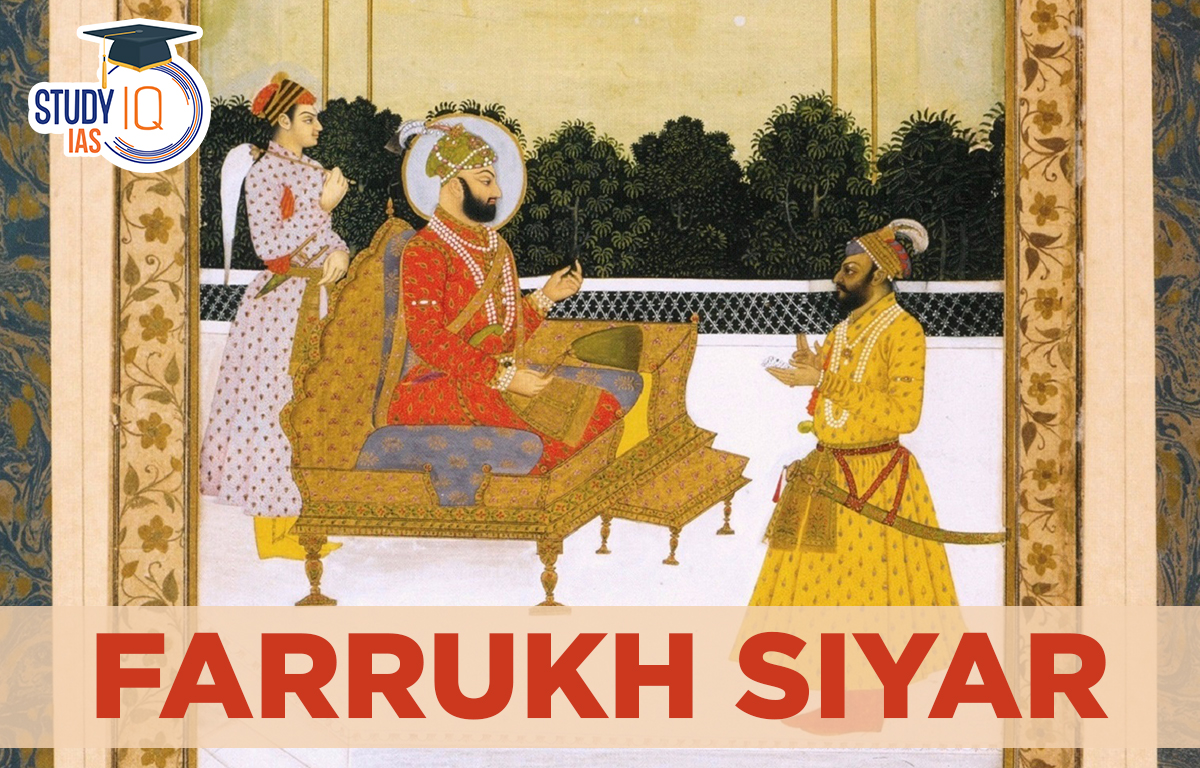Table of Contents
Farrukh Siyar
Farrukh Siyar was a vile poltroon who met the same end six years later, in 1719, as Jahandar Shah. With the assistance of two Mughal vazirs known as the Sayyid Brothers, Syed Hassan Ali Khan Barha and Syed Hussain Ali Khan Barha, he held the crown. The British East India Company acquired duty-free trading privileges in Bengal as a whole in 1717 from this fictitious emperor for a pittance of Rs. 3000 per year.
When there was animosity between the Sayyid Brothers and him, he lolled the throne like a puppet in their hands. When this happened, they deposed him, imprisoned him, starved him, blinded him, and eventually killed him. In 1719, the Sayyid brothers appointed his cousin Rafi ud-Darajat as king. This article has all the important facts and information related to Farrukh Siyar for UPSC Exam Preparations.
Read about: List of the Mughal Emperors
Farrukh Siyar Reign
Jahandar Shah’s rule came to an end in 1713 when he was defeated in Agra by his nephew Farrukh Siyar. The Sayyid brothers Abdullah Khan (Wazir) and Hussain Ali Khan helped him succeed to the throne (Mir Bakshi). The Sayyid brothers quickly seized control of the Mughal administration’s operations.
The Sayyid brothers desired to have individual power. The Sayyid brothers believed that only if they had actual power and the Emperor (Farrukh Siyar) merely reigned without governing could the Mughal administration be carried out correctly, the decline of the Empire stopped, and their own position secured. As a result, Sayyid Brothers and Emperor Farrukh Siyar engaged in a protracted power war. The Sayyid brothers overthrew and executed Farrukh Siyar in 1719.
Read about: Decline of Mughal Empire
Farrukh Siyar Farman
The English East India Company received benefits under Farrukh Siyar’s Farman (1717), including tax-free monopoly commerce, particularly in the Mughal subah of Bengal, Bihar, and Orissa. It was the result of extensive work by the corporation with the sole goal of avoiding paying customary taxes and tolls.
Many firm employees also worked as private traders, and they made an early effort to get the Mughals’ approval to engage in duty-free business in exchange for a fixed yearly payment (pexkash). The firm was spared from paying the traditional road fees (rahadari) in the provinces of Agra, Oudh, and surrounding areas by the imperial Farman (1650) of Shahjahan.
Read about: Later Mughal
Farrukh Siyar Significance in History
A successful battle against the Sikhs, whose commander Banda was overthrown and put to death, was led by Farrukh Siyar. Additionally, the rebellious Rajputs were suppressed. The English East India Company was given some unauthorised trade privileges during Farrukh Siyar’s rule, which was detrimental to the empire’s overall economic interests and, in particular, the subah of Bengal, Bihar, and Orissa.
He awarded the Imperial farman in response to the unjustified demands of the English, who were determined to establish a trading monopoly in the region (1717). This demonstrates his incapacity and ignorance of the potential consequences of his actions for the nation. Farrukh Siyar’s “Farman” laid the way for colonial control to be established in Bengal.
Farrukh Siyar Final Crisis
Ajit Singh was expelled from Gujarat by Farrukh Siyar on the grounds of tyranny, which alienated him. As a result, when Ajit Singh showed up in court, he took the wazir’s side. When Husain Ali left Aurangabad for Delhi in the late 1718 with 10,000 Maratha soldiers under the command of Peshwa Balaji Vishwanath, Farrukh Siyar was entirely alone save from Jai Singh’s assistance.
Husain Ali said that his trip to Delhi was justified by his desire to present Farrukh Siyar with a (fictitious) son of Prince Akbar that he had acquired from Shahu. We won’t delve into the specifics of what transpired that caused Farrukh Siyar to be deposed in February 1719 and killed in captivity a few months later. M. Amin Khan and Ajit Singh supported Husain Ali in the deposition. Khan-i-Dauran even favoured it.
In contrast, Abdullah Khan thought that retaining Farrukh Siyar in power was superfluous because the Saiyids’ troops had complete control over the fort and all positions that were near to the Emperor were either already occupied by their nominees or were about to be transferred to them.
However, because of heated citywide sentiment, 2,000 Marathas troopers were murdered, and the remaining ones were forced to flee. Jai Singh was lurking 20 kos from Delhi with 20,000 horsemen, and if some of the city’s nobility joined him, it would be difficult to maintain control of the situation. Farrukh Siyar has delayed appointing their candidates to all of the Saiyids’ required positions.
Whatever the problems, the Saiyids would never be able to make up for the mistakes made in detaining Farrukh Siyar and killing him afterwards. After the deposition, they were viewed as tyrants and betrayers of the salt rather than courageous individuals defending their lives and honour by rebelling against an unappreciative master. It also made it possible for the Turani nobility known as the “Chin” to emerge as guardians of the imperial Timurid rule and the vulnerable faith.
Farrukh Siyar UPSC
The Sayyid brothers Abdullah Khan and Husain Ali Khan Baraha, who received the positions of wazir and nur bakshi respectively, were responsible for Farrukh Siyar’s triumph. For the purpose of preparing for the UPSC Exam, this article provides detailed information about the Life and History of Farrukh Siyar.


 Desert Climate, Distribution, Climatic C...
Desert Climate, Distribution, Climatic C...
 Deserts of India Map, Features of Thar D...
Deserts of India Map, Features of Thar D...
 Maharashtra’s Mendrachi Vancharai Syst...
Maharashtra’s Mendrachi Vancharai Syst...





















